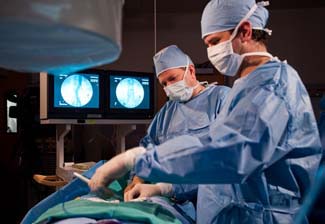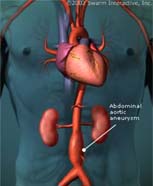Vascular Surgery
At Trinity Health Mid-Atlantic facilities, you have access to minimally invasive vascular and endovascular procedures, such angioplasty, stenting and atherectomy. Minimally invasive techniques are especially beneficial for patients who are elderly or who have increased surgical risk.
Our vascular teams also offer advanced surgical repair of diseased or damaged vessels.
Make an Appointment
Find a location close to home and call to make an appointment today.
Procedures include:

- Vascular bypass such as fem-pop bypass and aorto-bifemoral bypass
- Repair of abdominal aortic aneurysms
- Carotid endarterectomy
- Venous ablation revascularization
Our vascular specialists work closely with our wound centers and interventional radiologists to treat non-healing wounds and vein disease.

An abdominal aortic aneurysm (AAA) is a potentially fatal balloon-like swelling of a segment of the aorta, the largest artery in the body. Our vascular experts perform minimally invasive repair of AAA.
What is stent grafting?
In an abdominal aortic stent graft procedure, your doctor guides a catheter through a small incision in the upper thigh through the large blood vessel to the site of the aortic aneurysm in the abdomen. Once it is properly positioned, the stent graft (a woven polyester tube covered by a tubular metal web) is released from the delivery catheter, which is then withdrawn. The stent graft remains in place and allows blood to flow through the stent, entirely bypassing the aneurysm, and substantially reducing the risk of rupture. This less invasive procedure can decrease length of stay and recovery time significantly
Traditional AAA repair is an open-abdomen (or open-chest) surgery. The bulging aneurysm part of the aorta is removed, an artificial graft is put in its place, and the remaining aortic end-pieces are reattached to the graft.
Guided by sophisticated imaging technology, interventional cardiologists thread a stent through the artery and graft the weakened area to minimize the risk of rupture.
The carotid arteries supply the brain with vital oxygen and nutrients. Removing plaque that blocks these arteries can ultimately prevent a stroke. Our vascular experts can help.
What is carotid endarterectomy?
CEA is neck surgery to strip the inner lining of a carotid artery of obstructive plaque. The surgeon first makes an incision in the neck to access the narrowed carotid artery. Then the artery is opened and the plaque is removed. Finally, the artery is stitched back together. Once the plaque is removed, the artery diameter is wider, and blood can flow to brain tissue freely.
Femoral-Popliteal Bypass: The femoral arteries in the groin, and the popliteal arteries behind the knees, can both be areas of atherosclerotic plaque build-up. A healthy graft vessel is taken from elsewhere in the body (often the saphenous vein in the leg) and is attached to the femoral artery above the narrowing. The other end is attached to the popliteal artery behind the knee below the narrowed area. The blood will then flow easily through this new vessel, and avoid the plaque obstruction in the groin.
Aorto-Bifemoral Bypass: If the plaque build-up is higher up in the femoral arteries or in the iliac arteries, a different surgical bypass is necessary. This bypass requires an artificial graft that is shaped like an upside-down Y. The top part is attached to the aorta, and the bottom two pieces are attached to the femoral or iliac arteries, beyond the plaque obstruction. The blood will then flow from the aorta, into the graft, branch into two graft conduits, then back into the patient's own femoral or iliac arteries, and continue down the arteries of the legs.
Benefits of minimally invasive procedures
- One or a few small incisions
- Shortened recovery time
- Reduced risk of postop complications
- Reduced pain
- Less scarring

